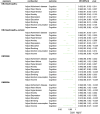Causal relationship and shared genetic pathways between diabetic kidney disease and cognitive impairment: a Mendelian randomization study
- PMID: 40592804
- PMCID: PMC12217110
- DOI: 10.1080/0886022X.2025.2525471
Causal relationship and shared genetic pathways between diabetic kidney disease and cognitive impairment: a Mendelian randomization study
Abstract
Background: Diabetic kidney disease (DKD) may increase cognitive impairment (CI) risk, but causal evidence remains limited. We aimed to investigate this causality and elucidate underlying genetic mechanisms.
Methods: Bidirectional two-sample Mendelian randomization (MR) was performed using summary statistics from four DKD genome-wide association studies (GWAS) and a large-scale cognitive function GWAS. Sensitivity analyses (heterogeneity, pleiotropy, leave-one-out, and Steiger directionality tests) confirmed the robustness of the results. Multivariable MR was used to adjust for potential confounders. Genetic correlation was assessed via linkage disequilibrium score regression (LDSC). Shared loci and pathways were identified through colocalization and functional enrichment analyses.
Results: DKD significantly increased cognitive decline risk (inverse-variance weighted (IVW) OR range: 0.55-0.88; all p < .05), with consistent results across sensitivity analyses. Multivariable MR confirmed that the association was independent of confounders. Significant genetic correlations were observed (LDSC rg = 0.072-0.201). Colocalization identified six shared risk loci (posterior probability for H4 (PP.H4) > 0.90). Enriched pathways included ribosomal function, mitochondrial oxidative phosphorylation, and neurodegeneration.
Conclusions: This study provides evidence supporting a causal relationship and genetic correlation between DKD and CI, while also identifying shared genetic features and biological pathways that may contribute to their association.
Keywords: Diabetic kidney disease; Mendelian randomization; cognitive impairment; genetic correlation; genome-wide association study.
Conflict of interest statement
No potential conflict of interest was reported by the author(s).
Figures







Similar articles
-
A Genome-wide study on the genetic and causal effects of smoking in neurodegeneration.J Transl Med. 2025 Jul 4;23(1):743. doi: 10.1186/s12967-025-06688-9. J Transl Med. 2025. PMID: 40615926 Free PMC article.
-
Bidirectional Causal Relationship Between Myopia and Neurodegenerative Diseases: Two-Sample Mendelian Randomization Analyses.Br J Hosp Med (Lond). 2025 Jun 25;86(6):1-19. doi: 10.12968/hmed.2025.0183. Epub 2025 Jun 18. Br J Hosp Med (Lond). 2025. PMID: 40554439
-
A Mendelian randomization study on the causal association of circulating cytokines with diabetic nephropathy.J Diabetes Investig. 2025 Jul;16(7):1274-1283. doi: 10.1111/jdi.70051. Epub 2025 Apr 30. J Diabetes Investig. 2025. PMID: 40304587 Free PMC article.
-
Causal insights into major risk factors for diabetic kidney disease: a comprehensive meta-analysis and Mendelian randomization study.Ren Fail. 2025 Dec;47(1):2468741. doi: 10.1080/0886022X.2025.2468741. Epub 2025 Feb 26. Ren Fail. 2025. PMID: 40012233 Free PMC article.
-
Impact of negative emotions and insomnia on sepsis: A mediation Mendelian randomization study.Comput Biol Med. 2024 Sep;180:108858. doi: 10.1016/j.compbiomed.2024.108858. Epub 2024 Jul 27. Comput Biol Med. 2024. PMID: 39067155 Review.
References
MeSH terms
LinkOut - more resources
Full Text Sources
Other Literature Sources
Medical
Miscellaneous
